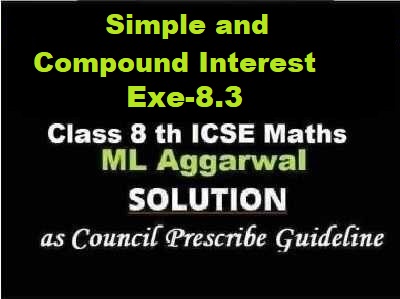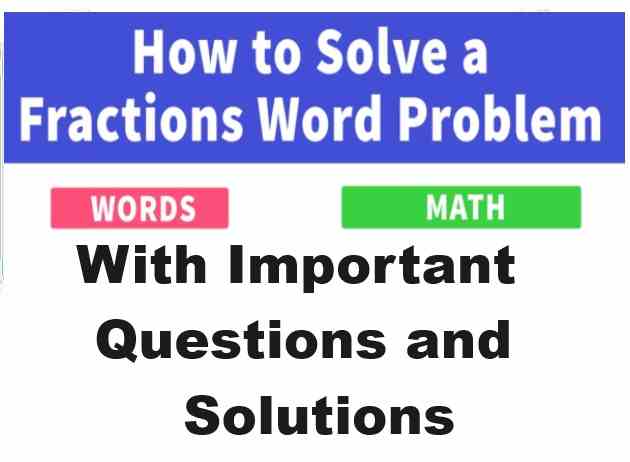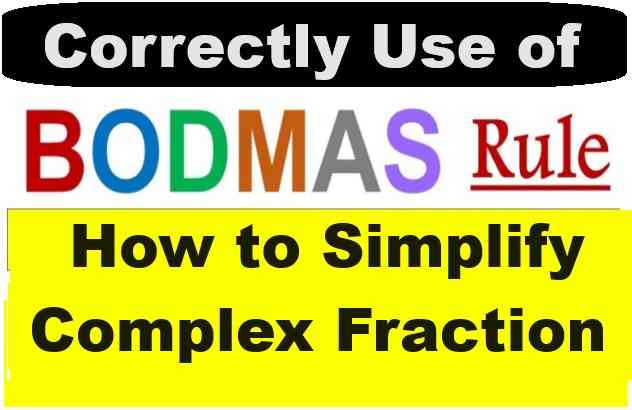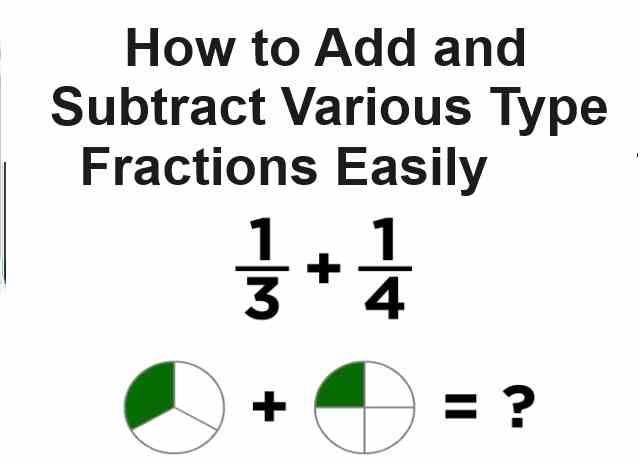ML Aggarwal Simple and Compound Interest Exe-8.3 Class 8 ICSE Ch-8 Maths Solutions. We Provide Step by Step Answer of Exe-8.3 Questions for Simple and Compound Interest as council prescribe guideline for upcoming board exam. Visit official Website CISCE for detail information about ICSE Board Class-8.
ML Aggarwal Simple and Compound Interest Exe-8.3 Class 8 ICSE Maths Solutions
| Board | ICSE |
| Publications | Avichal Publishig Company (APC) |
| Subject | Maths |
| Class | 8th |
| Chapter-8 | Simple and Compound Interest |
| Writer | ML Aggarwal |
| Book Name | Understanding |
| Topics | Solution of Exe-8.3 Questions |
| Edition | 2023-2024 |
Simple and Compound Interest Exe-8.3
ML Aggarwal Class 8 ICSE Maths Solutions
Page-144
Question 1. Calculate the amount and compound interest on
(i) ₹15000 for 2 years at 10% per annum compounded annually.
(ii) ₹156250 for 11⁄2 years at 8% per annum compounded half-yearly.
(iii) ₹ 100000 for 9 months at 4% per annum compounded quarterly.
Answer:
(i) Principal (P) = Rs 15000
Rate (R) = 10% p.a.
Period (n) = 2 years
Amount (A) = P {1 + (R / 100)}n
= Rs 15000 {1 + (10 / 100)}2
= Rs 15000 × (11 / 10) × (11 / 10)
= Rs 18150
Compound interest = Amount – Principal
= Rs 18150 – 15000
= Rs 3150
(ii) Principal (P) = Rs 156250
Rate (R) = 8% p.a. or 4% half-yearly
Period (n) = 1(1/2)years
= 3 half-year
Amount (A) = P {1 + (R / 100)}n
= Rs 156250 {1 + (4 / 100)}3
= Rs 156250 × (26 / 25)3
= Rs 156250 × (26 / 25) × (26 / 25) × (26 / 25)
= Rs 175760
Compound interest = Amount – Principal
= Rs 175760 – Rs 156250
= Rs 19510
(iii) ₹ 100000 for 9 months at 4% per annum compounded quarterly.
Principal (P) = ₹ 100000
Rate of interest = 4% p.a. or 1% quarterly
Period (n) = 9 months or 3 quarters
A=P(1+r/100)n
=100000(1+1/100)3=100000(1+1/100)3
By further calculation
= 100000 × 101/100 × 101/100 × 101/100
= ₹ 103030.10
Here
CI = A – P
Substituting the values
= 103030.10 – 100000
= ₹ 3030.10
Question 2. Find the difference between the simple interest and compound interest on ₹4800 for 2 years at 5% per annum, compound interest being reckoned annually.
Answer:
Principal (P) = Rs 4800
Rate (R) = 5% p.a.
Period (n) = 2 years
S.I. = PRT / 100
= (4800 × 5 × 2) / 100
= Rs 480
Amount (A) = P {1 + (R / 100)}n
= Rs 4800 {1 + (5 / 100)}2
= Rs 4800 × (21 / 20) × (21 / 20)
= Rs 5292
Compound interest = Amount – Principal
= Rs 5292 – Rs 4800
= Rs 492
Difference in compound interest and simple interest = Rs 492 – Rs 480
= Rs 12
Simple and Compound Interest Exe-8.3
ML Aggarwal Class 8 ICSE Maths Solutions
Page-145
Question 3. Find the compound interest on ₹3125 for 3 years if the rates of interest for the first, second and third year are respectively 4%, 5% and 6% per annum.
Answer:
Principal (P) = Rs 3125
Rate of interest for continuous 3 years = 4%, 5%, 6%
Period (n) = 3 years
Amount = P {1 + (r / 100)}n
= 3125 {1 + (4 / 100)} {1 + (5 / 100)} {1 + (6 / 100)}
= 3125 × (26 / 25) × (21 / 20) × (53 / 50)
= Rs 14469 / 4
= Rs 3617.25
Compound interest = Amount – Principal
= Rs 3617. 25 – Rs 3125
= Rs 492. 25
Question 4. Kamla borrowed ₹26400 from a Bank to buy a scooter at a rate of 15% p.a. compounded yearly. What amount will she pay at the end of 2 years and 4 months to clear the loan?
Answer:
Money borrowed (P) = Rs 26400
Rate (R) = 15% p.a.
Period (n) = 2 years 4 months
= 2(4/12)
= 2 (1/3)years
Amount = P {1 + (R / 100)}n
= Rs 26400 {1 + (5 / 100)2} × [1 + {15 / (3 × 100)}]1
= Rs 26400 × (23 / 20) × (23 / 20) × (21 / 20)
We get,
= Rs 366597 / 10
= Rs 36659.70
Question 5. Anil borrowed ₹18000 from Rakesh at 8% per annum simple interest for 2 years. If Anil had borrowed this sum at 8% per annum compound interest, what extra amount would he has to pay?
Answer:
Money borrowed (P) = Rs 18000
Rate (R) = 8% p.a.
Time (n) = 2 years
Simple Interest = PRT / 100
= Rs (18000 × 8 × 2) / 100
= Rs 2880
A = P {1 + (R / 100)}n
= Rs 18000 {1 + (8 / 100)}2
= Rs 18000 × (27 / 25)2
= Rs 18000 × (27 / 25) × (27 / 25)
= Rs 104976 / 5
= Rs 20995.20
Compound interest = Amount – Principal
= Rs 20995.20 – Rs 18000
= Rs 2995.20
Difference between compound interest and simple interest
= Rs 2995.20 – Rs 2880
= Rs 115.20
Question 6. Mukesh borrowed 775000 from a bank. If the rate of interest is 12% per annum, find the amount he would be paying after 1(1/2) years if the interest is
(i) compounded annually
(ii) compounded half-yearly.
Answer:
Money borrowed (P) = Rs 75000
Rate (R) = 12% p.a. or 6% half- yearly
Period (n) = 1(1/2)years or 3 half-years
(i) When the interest compounded yearly
Amount (A) = P {1 + (R / 100)}n
= Rs 75000 {1 + (12 / 100)} {1 + (6 / 100)}
= Rs 75000 × (28 / 25) × (53 / 50)
= Rs 89040
(ii) When the interest compounded half-yearly
Amount = Rs 75000 {1 + (6 / 100)}3
= Rs 75000 × (53 / 50)3
= Rs 75000 × (53 / 50) × (53 / 50) × (53 / 50)
= Rs 446631 / 5
= Rs 89326.20
Question 7. Aryaman invested ₹10000 in a company, he would be paid interest at 7% per annum compounded annually. Find
(i) the amount received by him at the end of 2 years.
(ii) the interest for the 3rd year.
Answer:
(i) Investment to a company (P) = Rs 10000
Rate of interest (R) = 7% p.a.
Period (n) = 2 years
Amount (A) = P {1 + (R / 100)}n
= Rs 10000 {1 + (7 / 100)}2
= Rs 10000 × (107 / 100) × (107 / 100)
= Rs 11449
(ii) Amount after 3rd year = Rs 11449 × (107 / 100)
= Rs 12250.43
Interest on the 3rd year = Rs 12250.43 – 11449
= Rs 801.43
Question 8. What sum of money will amount to ₹9261 in 3 years at 5% per annum compound interest?
Answer:
Amount (A) = Rs 9261
Rate of interest = 5% p.a.
Time (T) = 3 years
Principal (P) =?
A = P {1 + (r / 100)}t
9261 = P {1 + (5 / 100)}3
9261 = P (21 / 20)3
P = (9261 × 20 × 20 × 20) / (21 × 21 × 21)
= Rs 8000
hence, the sum of money = Rs 8000
Question 9. What sum invested for 11⁄2 years compounded half-yearly at the rate 8% p.a. will amount to ₹ 140608?
Answer:
Amount (A) = Rs 140608
Rate (R) = 8% p.a. = 4% half-yearly
Period (n) = 1(1/2)years = 3 half-year
A = P {1 + (R / 100)}n
140608 = P {1 + (4 / 100)}3
140608 = P (26 / 25)3
P = 140608 × (25 / 26) × (25 / 26) × (25 / 26)
P = Rs 125000
Principal = Rs 125000
Question 10. At what rate percent will ₹2000 amount to ₹2315·25 in 3 years at compound interest?
Answer:
Principal (P) = Rs 2000
Amount (A) = Rs 2315.25
Period (n) = 3 years
Let the rate of interest be r% p.a.
A / P = {1 + (r / 100)}n
2315.25 / 2000 = {1 + (r / 100)}3
{1 + (r / 100)}3 = (231525) / (100 × 2000)
{1 + (r / 100)}3 = 9261 / 8000
{1 + (r / 100)}3 = (21 / 20)3
1 + (r / 100) = 21 / 20
r / 100 = (21 / 20) – 1
r / 100 = 1 / 20
r = 100 / 20
r = 5
Hence, rate of interest = 5% p.a.
Question 11. If ₹40000 amounts to ₹46305 in 11⁄2 years, compound interest payable half-yearly, find the rate of interest per annum.
Answer:
Principal (P) = Rs 40000
Amount (A) = Rs 46305
Period (n) = 1(1/2)years = 3/2 years
So half yearly, 2n = 2 × (3/2) = 3 years.
Let the rate of interest be r% p.a.
A / P = (1 + r / 100)n
46305 / 40000 = (1 + r / 100)3
(1 + r / 100)3 = 46305 / 40000
(1 + r / 100)3 = 9261 / 8000
(1 + r / 100)3 = (21 / 20)3
(1 + r / 100) = (21 / 20)
r / 100 = (21 / 20) – 1
r / 100 = 1 / 20
r = 100 / 20
r = 5
Hence, rate of interest = 5% for half year.
So, 2 × 5 = 10% per annum.
Question 12. In what time will ₹15625 amount to ₹ 17576 at 4% per annum compound interest?
Answer:
Amount (A) = Rs 17576
Principal (P) = Rs 15625
Rate (R) = 4% p.a.
A / P = {1 + (r / 100)}n
17576 / 15625 = {1 + (4 / 100)}n
(26 / 25)3 = (26 / 25)n
n = 3
Hence, time = 3 years
Question 13. ₹ 16000 invested at 10% p.a. compounded semi-annually, amounts to ₹18522. Find the time period of investment.
Answer:
Principal (P) = Rs 16000
Amount (A) = Rs 18522
Rate (R) = 10% p.a. or 5% semi-annually
A / P = {1 + (r / 100)}n
18522 / 16000 = {1 + (5 / 100)}n
9261 / 8000 = (21 / 20)n
(21 / 20)3 = (21 / 20)n
n = 3 half years
Hence,
Time = 3 / 2 = 1(1/2)years
— : End of ML Aggarwal Simple and Compound Interest Exe-8.3 Class 8 ICSE Maths Solutions :–
Return to – ML Aggarwal Maths Solutions for ICSE Class -8
Thanks
Please Share with Your Friends




